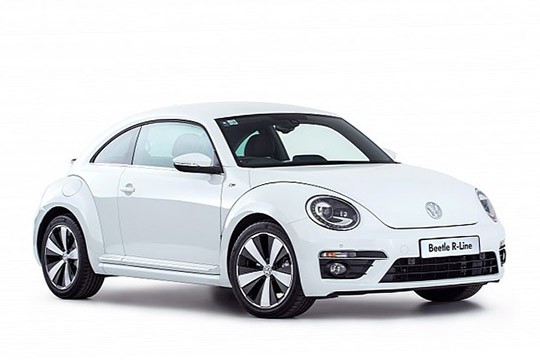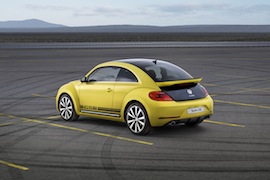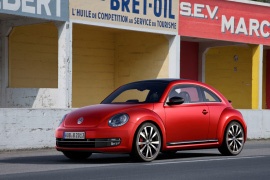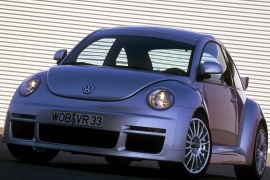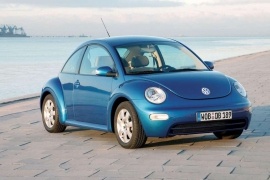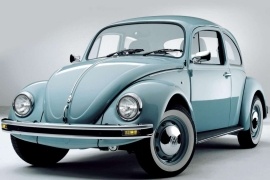VOLKSWAGEN Beetle Models/Series Timeline, Specifications & Photos
First production year: 1945
Engines: Gasoline, Diesel
Body style: Coupé (two-door)
Already iconic, the Beetle was the world’s best selling car with the most recognizable shape.
The first Beetle came to life in 1983, but it was sold under the nameplate of Type I, 1200, 1300 and 1500. The Beetle was also nicknamed „Bug”. The new models still hold the "people's car" design.
Volkswagen presented the coupe and the convertible Beetle in 2016, with three engine options: a 1.8-liter producing 170 hp, a 2.0-liter with 150 hp and the most powerful, a 2.0-liter 4-cylinder developing 210 hp. Users could choose between a 6-speed manual or automatic transmission, as well as a dual clutch one.
Most probably because the Beetle was mostly bought by women, Volkswagen redesigned the exterior to attract more male buyers. The Beetle no longer looks that happy, but it was still a cute car, rather than having an aggressive look. The roof was lowered and the windshield was more upright. As most german cars, the design lasted over the years.
The cabin was simple, practical, with a clean look. The front seats were comfortable, while the backseats offered little to no legroom and headroom.
The cargo area was decent for the coupe, but not the case for the convertible with the wind deflector collapsed.
The top of the range was represented by the Dune version of the Beetle, which was taller and wider than the others.
The Dune was also available in both coupe and convertible forms.
At the 2013 Chicago Auto Show, Volkswagen showed the limited edition Beetle GSR. The GSR was showed exactly 40 years after the first generation Beetle had also received a “GSR” version, for the racing enthusiasts. But since the former vehicle had a special engine installed, now the regulations didn't allow too much freedom of movement.
The three initials are coming from the german words “Gelb, Schwartz, Renner” (Yellow, Black, Racing). The reasoning behind the name is simple: all of the 3500 limited edition vehicles were yellow, with black decals.
Other special features for the GSR are the three gauges mounted on top of the dashboard, 19” light-alloy wheels and a stiffened suspension. Unfortunately, VW kept the same small disc brakes.
On the inside, there are more specific features. On the steering wheel, there is a metallic plaque with the serial number of the vehicle. There are going to be 1750 GSR's sold in U.S. and the rest in Europe. The price of the GSR starts at USD 30,000 in the U.S.
The engine is a four cylinder 2.0-liter TSI unit with 210 hp and 280 Nm (207 lb-ft) of torque. Performance numbers are at the same level as the Golf GTI. The sprint from 0 to 100 kph (62 mph) is done in 7.3 s. (0-60 mph in 6.6 s.) and the top speed is 229 kph (130 mph).
The first ever built Beetle was presented in 1938. It was officially named Volkswagen Type 1 and had a coupe body, with a rear engine and was intended for five occupants.
Back then, it was the so called “people’s car”. While at that time, being an economy car, it suited people’s needs, years later, Volkswagen was forced to drastically redesign the Beetle to access a wider range of buyers and raise the sales.
The retro-fun aspect was kept, however, the Beetle became a sportier, roomier and cheaper vehicle.
The first official photos of the 2011 Beetle were released just a few days before its official launch at the New York International Auto Show.
The 2011 model came with a lower stance, while also having a longer and wider body. The car sported 19-inch wheels and plenty of luxury equipment as compared to its predecessor, as well as enough engine choices to fit all demands.
For the first time in history buyers could get a Beetle with bi-xenon headlights as well as LED daytime running lights. More equipment included keyless access, a 6.5-inch touchscreen infotainment system, a panoramic roof, a push-start button, automatic climate control and even a premium sound system by Fender.
The components of the Beetle were the same as for the Golf and other models in the VW Group.
The engines ranged from a 1.2-liter to the GTI 2.0-liter with 197 hp.
VOLKSWAGEN Beetle 1.2L TSI 6MT FWD (105 HP)
VOLKSWAGEN Beetle 1.2L TSI 7AT FWD (105 HP)
VOLKSWAGEN Beetle 1.2L TSI BlueMotion 6MT FWD (105 HP)
VOLKSWAGEN Beetle 1.4L TSI 6MT FWD (160 HP)
VOLKSWAGEN Beetle 1.4L TSI 7AT FWD (160 HP)
VOLKSWAGEN Beetle 1.4L TSI BlueMotion 6MT FWD (150 HP)
VOLKSWAGEN Beetle 1.4L TSI BlueMotion 7AT FWD (150 HP)
VOLKSWAGEN Beetle 1.8L Turbo 6AT (170 HP)
VOLKSWAGEN Beetle 1.8L Turbo 6MT FWD (170 HP)
VOLKSWAGEN Beetle 2.0L TSI BlueMotion 6AT FWD (220 HP)
VOLKSWAGEN Beetle 2.0L TSI BlueMotion 6MT FWD (220 HP)
VOLKSWAGEN Beetle 2.0L Turbo 6AT FWD (200 HP)
VOLKSWAGEN Beetle 2.0L Turbo 6MT FWD (200 HP)
VOLKSWAGEN Beetle 2.0L Turbo 6MT FWD (210 HP)
VOLKSWAGEN Beetle 1.6L TDI 5MT FWD (105 HP)
VOLKSWAGEN Beetle 1.6L TDI 7AT FWD (105 HP)
VOLKSWAGEN Beetle 1.6L TDI Bluemotion 5MT FWD (105 HP)
VOLKSWAGEN Beetle 1.6L TDI Bluemotion 7AT FWD (105 HP)
VOLKSWAGEN Beetle 2.0L BlueMotion 6AT FWD (150 HP)
VOLKSWAGEN Beetle 2.0L TDI 6AT FWD (140 HP)
VOLKSWAGEN Beetle 2.0L TDI 6MT FWD (140 HP)
VOLKSWAGEN Beetle 2.0L TDI BlueMotion 5MT FWD (110 HP)
Built on the same platform as its Golf sibling from the same era, the Beetle appealed to the collective memory and followed the retro-design trend.
While the Golf and the rest of the compact-sized vehicles built by the Volkswagen Group were mainly built for practicality, the Beetle was created to attract the old times. Some people grew up with their parents' old Beetle and tried to get the same feelings now on board this rounded vehicle. Unlike the original Beetle, this one came with both the engine and the transmission at the front.
The car's front fascia featured rounded headlights that clearly mimicked the old Beetle's ones. Moreover, it didn't even feature an upper grille, just a low-mounted one into the apron. From its sides, the entire car looked like it was designed using just three half-circles: one for the greenhouse and the other two for the front and rear wheel arches. Its tall side windows and long doors allowed passengers to easily get in and out of the cabin. Its sloped back, with a wide windscreen, also resembled its ancestor.
Inside, Volkswagen created an airy cabin with two bucket seats at the front and a bench in the back. The Beetle's dashboard was one of the most attractive parts of the vehicle. Its minimalist design was complemented by a round instrument cluster that resembled the original Beetle. In addition, the automaker placed a small vase and support next to the dials, so the owner could put a small flower in there.
Volkswagen installed a wide choice of engines, depending on the market. While the Europeans got the famous TDI engines, the U.S. customers were treated mostly with gas-powered inline-fours.
An unexpected model from the VW Group was released in 2001. Everybody was familiar with the iconic Beetle, but it was time for VW to step up and create something different.
The RSI Beetle was the rarest car VW ever made, with only 250 units produced. Actually - 251. All 250 RSIs were painted in silver with orange seats inside, however, the 251st was blue and belonged to a former VW manager.
Was RSI was not only the rarest, but the most expensive Beetle with a starting price of $80.000. No, it’s not a typo.
While the vast majority of producers add some extra details to the exterior of their sporty versions to emphasise aggressiveness, the Beetle had a complete body kit. Lowered ground clearance, air intakes, a huge rear spoiler, incredible Remus double exhaust and rally style 18-inch alloy wheels.
To match the exterior, the engine under the hood had to be a powerful one. VW took the Golf’s R32 VR6 engine and borrowed it to the RSI. That meant no less than 220 hp for the small Beetle.
The interior of the RSI had bucket orange seats, an engine start button placed between the front seats and was full of carbon fiber and aluminum. I said full because the doors and the seats were entirely made of carbon fiber, thus making them very light weight.
The gear shifting knob wore the VW’s 4Motion badge and it was very short and mechanical.
Nothing outside of the ordinary beside the specific extra dial gauges with oil pressure indicator, battery and others.
The RSI had no power windows, but had heated seats.
The radio was placed up the roof and the headliner was covered in Alcantara.
Volkswagen revived the famous Beetle nameplate in 1998 when it introduced the Golf-based, round-shaped vehicle on the market, bringing a breath of fresh air into the German carmaker's lineup.
While the original model, although heavily upgraded, of the Beetle was still produced in Mexico, Volkswagen decided that it was time for a new model to carry on the car's legacy that built the German brand. Thus, in 1994, at the North American International Auto Show, the carmaker unveiled a concept car named Concept One that announced the revival of the Beetle. By 1997, the concept car became a reality.
Developed during the full biodesign era, the Beetle resembled some of its ancestors' features, such as the curved, oversized fenders. Its sloped, round headlights were mounted on a front fascia that didn't show an upper grille. Unlike the original version, this time, the Beetle was a front-engined vehicle, so it needed a cooling area that was incorporated into the lower bumper. The bubble-like appearance was emphasized by the sloped rear end, where a tailgate opened to reveal the trunk. Last but not least, the carmaker added a pair of round taillights.
The interior followed the same retro-design concept, with a round instrument cluster that sported the speedometer and the fuel and temperature gauges. The design was complemented by a small vase placed next to the steering wheel. On the center stack, Volkswagen installed the AC unit and the stereo. The Beetle offered seating for four, with a split-folding (50/50) rear bench and two bucket seats at the front.
The 1998 Beetle shared its underpinning with the well-known Golf IV, featuring McPherson front suspensions and trailing arms at the rear. Under the hood, the carmaker added a choice of gasoline and turbo-diesel engines. Last but not least, it was offered with either a manual or an automatic transmission for selected engines.
The Beetle was one of the most important cars ever made. It was produced in over 21 million units. After WWII, from the remains of its factory, Volkswagen was reborn due to the little car.
Designed by one of the greatest automotive engineers in history, Dr. Ferdinand Porsche, by the order of the most feared dictators, Adolf Hitler, the VW 1200 was revived in 1945 with the help of the British Army officer Ivan Hirst. He convinced the British Army to order 20.000 cars.
The Beetle was a car built over an X-type chassis. The car's design was made by Ferdinand Porsche since the beginning of the '30s with the 1932 Porsche Type 12. Apart from the flat windows, the rest of the car was rounded. To ease-up the assembly process, the fenders were bolted onto the main body. In 1945, when the production was restarted, there were some modifications to the original concept and a split-window appeared in 1949.
The interior of the car was basic, with two seats in the front and a bench in the back. The flat dash panel was metallic and featured one dial before 1945. A set of turn-signals was installed in the car.
The engine was a flat-four. All Beetle had a flat-four since its conception. After the war, the only engine available was a 1.1-liter unit. Over time it evolved to a 1.2-liter and then a 1.3-liter unit. Some later vehicles were upgraded to single-point injection instead of carburetors and a 1.6-liter unit. A manual four-speed on the floor was the only option for a long time. Later on, some models were fitted with a 3- and 4-speed semiautomatic. Production ended in July 30 2003, in Volkswagen's factory from Mexic.
